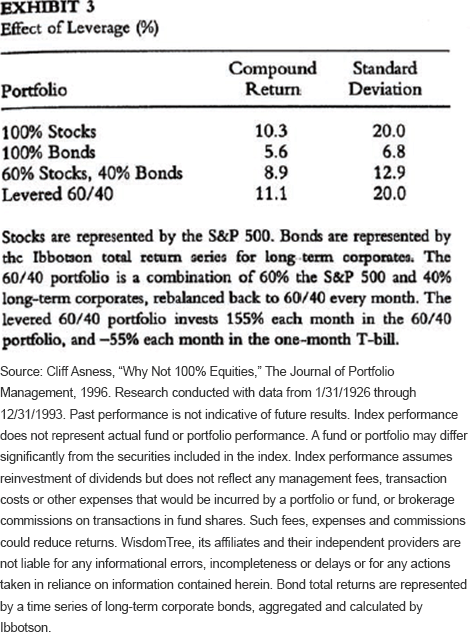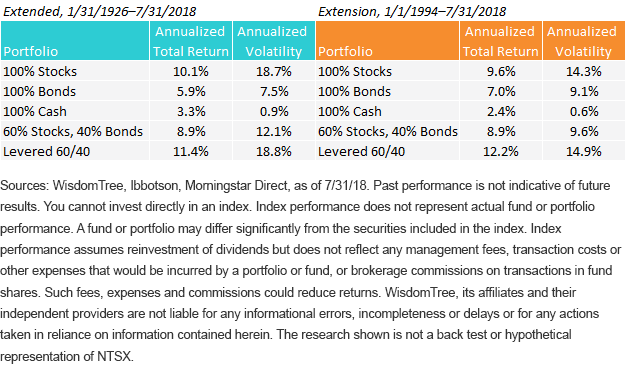Research on a Levered 60/40 Approach vs. 100% Equities


Following the launch of the WisdomTree 90/60 U.S. Balanced Fund (NTSX), Cliff Asness, co-founder of AQR Capital Management, commented on Twitter that although he had a “22-year head start” from a research perspective (linking to a piece he wrote in December of 1996 serving as Goldman Sachs Asset Management’s director of quantitative research), WisdomTree managed to “beat him” in launching this type of levered 60/40 idea in an exchange-traded fund.
In Asness’s 1996 piece, titled “Why Not 100% Equities: A Diversified Portfolio Provides More Expected Return per Unit of Risk,” one of his core arguments was that an “investor willing to bear the risk of 100% equities can do even better with a diversified portfolio.”
Asness showed how the use of leverage, which we discuss below, when applied to a traditional 60/40 strategy, could achieve a similar volatility of the 100% equity exposure but could help improve the return. Asness’s paper, based on data from 1926 through 1993, applied a 155% leverage rate to a 60/40 portfolio (applied monthly), where the borrowing rate used for leveraging his 60/40 portfolio was done at a cost of financing by the one-month t-bill rate. This is a table from his paper:
Figure 1: Return and Volatility Table from Asness’s “Why Not 100% Equities” Paper

For definitions of terms in the chart, please visit our glossary.
The Asness Research vs. the WisdomTree 90/60 approach
While aspects of the two are similar, there are, of course, some very important differences between the approach of the WisdomTree 90/60 U.S. Balanced Fund and its targeted exposures from the research that Asness published.
The similarities between the two strategies come from the equity exposures. The large-cap ‘equity beta’ exposure in the WisdomTree Fund targets S&P 500-like returns, are as such, overlaps what we see in Asness’ piece. However, there are more distinct differences on the bond exposure side of the equation.
Asness showed returns for bonds using the long-term corporate series from Ibbotson, funding these bond returns by borrowing at the one-month t-bill rate, so an investor could earn both credit and duration premiums over the t-bill rate.
Bond Futures vs. Corporates
WisdomTree is implementing bond exposure in the WisdomTree 90/60 U.S. Balanced Fund through laddered Treasury bond futures. No one earns “credit risk” premiums through this Treasury bond futures exposure, so there is less additional income to be earned from that perspective.
Although there are very important differences between our strategy implementation and the Asness study, we think that study is very useful in understanding the market dynamics at work in a levered 60/40 approach. Thus, we wanted to replicate and update the results of Asness’s paper for the next 25 years to see how his research would have worked after the article was published.
Our calculations use the same Ibbotson data series and methodology: borrowing -55% at the one-month t-bill rate that finances the 155% exposure every month in the 60/40 mix of S&P 500 and the Ibbotson corporate bond series. Our independent calculation of Asness’s test showed the same compound return figures.
Figure 2: WisdomTree’s Replication of Asness’s Results (1/31/1926–12/31/1993)


For definitions of terms in the chart, please visit our glossary.
When we updated the figures for the next 25 years, we saw that stocks returned a bit lower over that time, dragging down the full-period returns for equities but also lowering equity volatility. While the compounded S&P 500 returns ticked down 20 basis points (bps) from 10.3% to 10.1% when updated through 2018, the bonds compounded returns ticked 30 bps higher, from 5.6% to 5.9%, so a 60/40 portfolio had unchanged returns at 8.9%.
Because cash rates generally also ticked down over the 25-year period after Asness published the paper, the levered 60/40 returns using Asness’s assumptions/calculations ticked up 30 basis points from 11.1% to 11.4% when updated to 2018, and the spread between 100% equities and the levered 60/40 widened out from 80 bps at the time of his original study to 130 bps over the full 1926–2018 period. When people publish research, often the research itself gets a reputation of “failing to replicate out of sample.” Asness’s study, and the levered 60/40 portfolio utilizing the same approach he outlined in the paper, actually saw portfolio returns outperform in the following 25-year period compared to its historical back test. The levered 60/40 portfolio returned 12.2% for the 1994–2018 period, 260 bps ahead of the 100% equity line, compared with only 80 bps during his original test.
Current Equity vs. Bond Debates
Right now, one of the core asset allocation conundrums remain: interest rates generally are still near their lowest levels, and, as such, one doesn’t earn as much from bonds as in the past. Similarly, equity valuations are extended from historical levels, so forward-looking equity returns are also lower than normal.
The conundrum for traditional asset allocators, however, is that equity premiums (how much compensation stocks are offering over safe assets like bonds) are likely still favoring stocks in asset allocation models.
Professor Jeremy Siegel, under whom I have studied extensively, believes the current equity premium over bonds is around 4.5%, whereas his work historically over the last 200 years shows the real equity premium was closer to 3%.
Important Risks Related to this Article
There are risks associated with investing, including possible loss of principal. While the Fund is actively managed, the Fund’s investment process is expected to be heavily dependent on quantitative models, and the models may not perform as intended. Equity securities, such as common stocks, are subject to market, economic and business risks that may cause their prices to fluctuate. The Fund invests in derivatives to gain exposure to U.S. Treasuries. The return on a derivative instrument may not correlate with the return of its underlying reference asset. The Fund’s use of derivatives will give rise to leverage, and derivatives can be volatile and may be less liquid than other securities. As a result, the value of an investment in the Fund may change quickly and without warning and you may lose money. Interest rate risk is the risk that fixed income securities, and financial instruments related to fixed income securities, will decline in value because of an increase in interest rates and changes to other factors, such as perception of an issuer’s creditworthiness. Please read the Fund’s prospectus for specific details regarding the Fund’s risk profile.
Diversification does not eliminate the risk of experiencing investment losses.

Jeremy Schwartz has served as our Global Chief Investment Officer since November 2021 and leads WisdomTree’s investment strategy team in the construction of WisdomTree’s equity Indexes, quantitative active strategies and multi-asset Model Portfolios. Jeremy joined WisdomTree in May 2005 as a Senior Analyst, adding Deputy Director of Research to his responsibilities in February 2007. He served as Director of Research from October 2008 to October 2018 and as Global Head of Research from November 2018 to November 2021. Before joining WisdomTree, he was a head research assistant for Professor Jeremy Siegel and, in 2022, became his co-author on the sixth edition of the book Stocks for the Long Run. Jeremy is also co-author of the Financial Analysts Journal paper “What Happened to the Original Stocks in the S&P 500?” He received his B.S. in economics from The Wharton School of the University of Pennsylvania and hosts the Wharton Business Radio program Behind the Markets on SiriusXM 132. Jeremy is a member of the CFA Society of Philadelphia.

